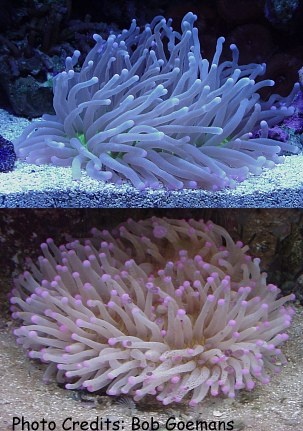
By Bob Goemans

Likely Reef Tank Suitable
Likely Fish-Only Tank Suitable
Range: Indian Ocean: Southeastern India to Tropical Western Pacific, and from Australia north to Southern Japan.
Natural Environment: Inhabits fairly shallow soft sand and coral rubble zones on reef slopes and lagoon flats, and interconnected sandy reef areas protected from strong wave motion and usually seen at depths between 3 - 85 feet (1 - 25 m).
General Husbandry: Common in the trade.
Best located on sandy or course substrate in areas receiving bright light and moderate water movement. Even though photosynthetic, it should be fed at least once per week meaty foodstuffs, e.g., fortified brine shrimp, mysis, products containing Cyclop-eeze or similar products, and/or other marine diced/graded meaty foods. Its long tentacles are a good indicator that hand feeding is important to the long-term health of this species. Feeding should be at timeframes when tentacles are the most prominent, which normally is somewhat more during nighttime hours. If that's not feasible, anytime will suffice if the specimen takes the food.
Even though this coral is considered quite safe when it comes to damaging other corals it may come in contact with, it is itself rather sensitive to injury from other corals! Therefore, place in areas where other corals will not come in contact with it, and never place on ledges where it can fall and be injured, as their recovery rate from injuries is somewhat dismal. And because of that, always look for a healthy undamaged specimen when shopping for an addition to your aquarium.
Taxonomy:
Kingdom: Animalia
Phylum: Cnidaria
Class: Anthozoa
Subclass: Hexacorallia
Order: Scleractinia
Family: Fungiidae
Genus: Heliofungia
FYI: This is a free-living photosynthetic stony coral (except for juveniles) and is usually saucer-shaped. It is a single polyp coral with one central, striped mouth and long anemone-like tentacles, which remain extended day and night.
Juveniles are often attached to rock or coral and become detached, as they grow larger. The most common color is tan with white tipped tentacles, yet I've see other colors or combination of colors, such as white with pink/violet tips and varying colors of green with white tips.
Do not remove a specimen with inflated flesh from the water as the weight of the water in the flesh may damage/tear the flesh. Gently shake the specimen and allow the flesh to retract before removing.
Experience Level: Beginner
Diet: Photosynthetic/Plankton feeder
Temperament: Peaceful
Aquarium Environment: Reef or fish-only aquarium
Coral Safe: With caution
Fish Safe: Yes
Invertebrate Safe: With caution
Acclimation Time: 30 minutes+
Aquarium Hardiness: Hardy
Calcium (Ca): 380 - 430 mg/l
Alkalinity: 2.5 - 3.0 meq/l
Phosphate (PO4): <0.05 mg/l
Magnesium (Mg): approx. 1350 mg/l (relate to specific gravity)
Strontium (Sr) 8 - 10 mg/l
Temperature Range: 74 - 83°F (23 - 28°C)
Minimum Tank Size: 100 gallons
Lighting: PAR 300 - 400+
Water Movement: WM 2
Specific Gravity: 1.023 - 1.025
pH: 8.0 - 8.4
Iodine/Trace Elements Monitor/as necessary to maintain quality seawater.
